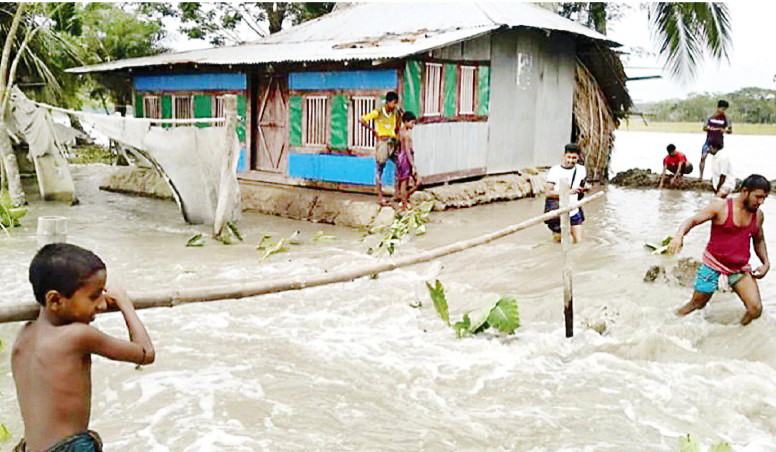
Flood-hit rural poor feel abandoned

Food and clean water have become scarcer in the flood-affected areas as more and more people are being affected by the flood and the government relief remained far less than the demand.
Forecasters saw no possibility of improvement of the situation in July as rivers slowly drained to the sea amid the worsening flood situation in central Bangladesh, especially in some areas in Dhaka, where major rivers around the city crossed their danger marks on Monday.
Among over 4.7 million flood-affected people, about a quarter of them were marooned for almost a month, the government distributed only 12,510 tonnes of rice, less than a third of the rice allocated in June for feeding about two million urban poor hit by the coronavirus crisis.
‘I feel so alone amidst all these waters. There is nobody to help, and no one to ask how I was still alive,’ Shefali Khatun, 32, a resident of Char Ramna of Chilmari in Kurigram, told New Age.
‘I got only two pieces of bread as relief but not from the government,’ she added.
The hardest hit flood affected areas include some of the country’s poorest rural areas, such as villages in Kurigram and Gaibandha, where more than half the population lived below the poverty line even before the coronavirus crisis emerged, in the last three months before the flood.
Shefali’s husband died of cardiac arrest five days after the flood hit over a month ago and she, with her four children, has been living on an embankment ever since.
‘I live on others’ wastes,’ said Shefali, who spends long hours every day begging for foods, since all her alternative sources of food, the wild plants and roots from nearby bushes she used to eat by boiling, have gone under water.
Meanwhile, Ramna union parishad chairman Akbar Ali received two tonnes of rice for 26,000 flood affected people so far.
‘The poor never needed the government so much,’ said Akbar Ali, adding that the rice he received was far below the demand.
Over 6,882 people were driven out of their homes as flood deteriorated in many areas in eight flood-hit districts in Rangpur division between Sunday and Monday, increasing the number of people living on embankments to 53,000.
The official estimate showed more than 3.23 lakh people were freshly affected by flooding during the same time in 31 districts.
Besides rice, the government also distributed Tk 3.36 crore and 1.32 lakh packets of dry foods among the flood victims and nearly Tk 3 crore for baby food, fodder and house repairing costs.
Some local representatives found the government relief response so poor that they said withdrawing the relief was not worth the trouble.
‘Three tonnes of rice for 14,561 people stranded in water for weeks is next to nothing,’ said Mofazzal Hossain, chairman, Rajpur union parishad, Lalmonirhat, who did not bother withdrawing government’s relief allocation.
Jamalpur, the worst-hit district with 9.94 lakh affected, got only 910 tonnes of rice and Tk 29.50 lakh in government relief assistance.
Kurigram deputy commissioner Md Rezaul Karim said that he could help only 8,000 of 56,000 affected families so far.
Individual relief initiative is scarce this year and the government relief distribution largely remained limited to sheltered people.
Crises faced by hundreds of thousands staying on raised platforms inside their homes or on rooftops remained largely unknown to the government and the national media covering floods centred on cities or towns.
Flood Forecasting and Warning Centre on Monday said that the rivers may rapidly swell over the next three days because of heavy to very heavy rains in West Bengal and Assam and Meghalaya.
The FFWC said that the rivers around Dhaka may keep swelling through Tuesday as Turag in Mirpur and Tongi Khal in Tongi crossed their danger marks on Monday.
The Shitalakkhya, Balu, Kaliganga and Dhaleshawri have been flowing above their danger levels in the last several days.
The FFWC said that 20 rivers were flowing above their danger levels in 30 places across the country.
Bangladesh Meteorological Department forecasted light to moderate rains across Rangpur and Rajshahi and at many places of Dhaka, Mymensingh and Sylhet divisions until Tuesday morning.
Health emergency control room reported three deaths in the last 24 hours until 8:00am on Tuesday with the death tally in flood-related causes climbing to 122.
New Age correspondent in Sirajganj reported that though the Jamuna receded by four centimetres until Monday noon, the flood situation worsened in the district where 4.43 people are affected by the flood.
Editor & Publisher: S. M. Mesbah Uddin
Published by the Editor from House-45,
Road-3, Section-12, Pallabi, Mirpur
Dhaka-1216, Bangladesh
Call: +01713180024 & 0167 538 3357
News & Commercial Office :
Phone: 096 9612 7234 & 096 1175 5298
e-mail: financialpostbd@gmail.com
HAC & Marketing (Advertisement)
Call: 01616 521 297
e-mail: tdfpad@gmail.com